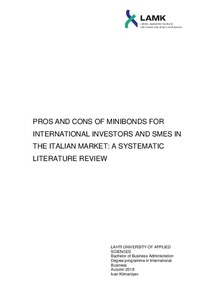PROS AND CONS OF MINIBONDS FOR INTERNATIONAL INVESTORS AND SMES IN THE ITALIAN MARKET: A SYSTEMATIC LITERATURE REVIEW
Klimentyev, Ivan (2018)
Julkaisun pysyvä osoite on
https://urn.fi/URN:NBN:fi:amk-2018121521758
https://urn.fi/URN:NBN:fi:amk-2018121521758
Tiivistelmä
The core objective of this thesis was to help international investors understand the advantages and disadvantages of investing in Italian minibonds. The Minibond program was initiated by the Italian government in 2012 as an alternative debt finance for Italian SMEs. This is a new debt product and many international investors around the world are not familiar with it. In the same way, many Italian SMEs are not familiar with the benefits and limitations of raising debt finance through the minibond issuance. This study provides potential investors with an overview of such instruments as well as assesses the main features of minibonds. The study also helps the Italian SMEs to understand the pros and cons of raising debt finance through the minibond issuance.
In recent years, the amount of publications in regard to the Italian mini-bonds has surged. However, the information available on this topic is very fragmented. Only separate studies have been done with the focus on particular aspects of the Italian mini-bonds. There is a need to summarize the information available in a clear way. In order to answer the research question, a systematic literature review was conducted. The secondary data was collected in a structured way and analyzed according to the guidelines for a systematic literature review.
The findings of this thesis showed that under certain conditions, it is cheaper for Italian SMEs to raise debt finance through the minibond issuance. Minibonds provided a more desirable length of debt financing for Italian SMEs. However, for small companies, legal costs associated with the minibond issuance are too high. For the international investors, the biggest advantage of investing in minibonds is the high return on the investment and in some cases the exception from the withholding tax on the interest earned. However, minibond investors bear high credit risks. In addition, the minibond market in Italy greatly lacks liquidity.
In recent years, the amount of publications in regard to the Italian mini-bonds has surged. However, the information available on this topic is very fragmented. Only separate studies have been done with the focus on particular aspects of the Italian mini-bonds. There is a need to summarize the information available in a clear way. In order to answer the research question, a systematic literature review was conducted. The secondary data was collected in a structured way and analyzed according to the guidelines for a systematic literature review.
The findings of this thesis showed that under certain conditions, it is cheaper for Italian SMEs to raise debt finance through the minibond issuance. Minibonds provided a more desirable length of debt financing for Italian SMEs. However, for small companies, legal costs associated with the minibond issuance are too high. For the international investors, the biggest advantage of investing in minibonds is the high return on the investment and in some cases the exception from the withholding tax on the interest earned. However, minibond investors bear high credit risks. In addition, the minibond market in Italy greatly lacks liquidity.

